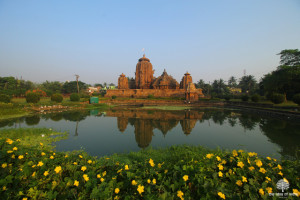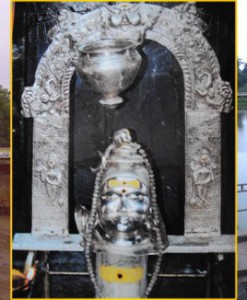No products in the cart.
Brahmeswara Temple is a Hindu temple dedicated to Shiva located in Bhubaneswar, Odisha, erected at the end of the 9th century CE, is richly carved inside and out. This Hindu temple can be dated with fair accuracy by the use of inscriptions that were originally on the temple. They are now lost, but records of them preserve the information of around 1058 CE. The temple is built in the 18th regnal year of the Somavamsi king Udyotakesari by his mother Kolavati Devi, which corresponds to 1058 CE.
Brahmeswara Temple, Orissa
- Temple History
- Architecture
- How To Reach The Temple
- Daily Poojas And Festivals
- Video
- Additional Information
Historians place the temple to belong to the late 11th century as ascertained from an inscription carried to Calcutta from Bhubaneswar. The inscription indicates that the temple was built by Kolavatidevi, the mother of Somavamsi king Udyota Kesari. It was built with four Natyasalas at a place known as Siddhatirtha in Ekamra (modern day Bhubaneswar). The inscription was recorded during the 18th renal year of Udyotha Kesari, corresponding to 1060 CE. Since the inscription is not in its original place, historians indicate the possibility of the reference to another temple, but based on the location and other features specified, it is ascertained that the inscription belongs to the temple. Also, another issue raised by Panigrahi is that the four cardinal temples are Angasalas (associate temples) and not Natyasalas (dance halls) as indicated in the inscription.
Architecturally, the temples of Bhubaneshwar can be resolved into three broad styles as rekha, pidha and khakhara. Most of the temples of the first two orders have two main components–the sanctum, with a convex curvilinear spire, locally known as the deul, also called bada deul (the big temple) or the rekha deul (temple of which the spire gives the optical impression of one continuous line), which towers over the sanctum having the deity image; and an entrance porch or assembly hall called jagamohana, or pidha deul (a temple of which the root is made up of horizontal platforms or pidhas), characterized by a stepped pyramidal roof.
The bigger temples may have two to three of these porches–usually a nata-mandira (dance hall) and bhoga-mandapa (hall of offering). A khakhara style is distinguished by a barrel elongated roof, called khakhara–the local name of a variety of pumpkin-guard. Over the khakhara are placed kalasas or amlas flanked by lions.
The outside of temples are profusely decorated with sculptured relief broadly classified as – hieratic deities, human beings, geometrical, birds and animals and the floral patterns. The iconography includes the divine images, representation of planets, dikpalas and their female counterparts.
More than 500 temples that remain in Bhubaneswar, some significant, of the early period (7-9th century AD) are the Parasuramesvara and Vaital Deul; the middle period (10-11th century), the temple such as the Muktesvara, the Rajarani and the Lingaraja; and the later period (12-13th century), the Ananta Vasudeva, the Meghesvara and the Yamesvara, are architecturally typical and impressive. Most of these are active places of worship.
By Road: Brahmeswara Temple, Bhubaneswar is well connected to all parts of the state and nearby states by road network. It is situated on the National Highway. Odisha State Road Transport Corporation (OSRTC) is frequently available to reach Brahmeswara Temple, Bhubaneswar from anywhere in Orissa.
By Rail: It is well connected through nearest Bhubaneshwar railway station
to major cities railway stations like Delhi, Agra, Mumbai, Chennai, Ajmer, Pali, Jaipur, Ahmedabad.
By Air:The nearest Airport is Bhubaneswar Airport which is well connected with regular domestic flights to Delhi, Mumbai.
Temple remains open from 6am to 8pm. During this period major rituals of Lord Shiva are performed. Mahashiva Ratri is celebrated at a grand scale in this temple.
This is very ancient temple as it was built in the 9th century. This is considered to be a smaller version of the Lingaraj Temple. This temple is surrounded from all sides by the well maintained gardens. On visiting this temple you will notice that on a pedestal are four small structures. This temple is well known for it very intricately designed erotic sculptures and carvings.











